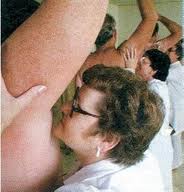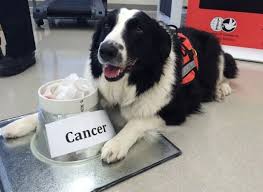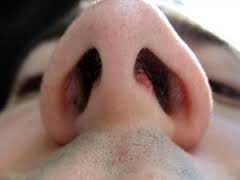DOWNLOAD THE ENTIRE SEPTEMBER 2016 NEWSLETTER including this month’s Freebie.
Being alive is a smelly business.
 Our bodies constantly release by-products of the processes that go on inside us—and it is more than just a curiosity or a cause for dismay. A growing amount of research suggests that it might one day be possible to sniff someone’s breath, skin or bodily fluids to help diagnose a disease.
Our bodies constantly release by-products of the processes that go on inside us—and it is more than just a curiosity or a cause for dismay. A growing amount of research suggests that it might one day be possible to sniff someone’s breath, skin or bodily fluids to help diagnose a disease.
For years researchers have investigated the idea that animals, especially dogs, might be able to tell sick people from healthy individuals by smell. For some diseases (for example, epilepsy), trained animals can be surprisingly good at it. Devices that detect volatile compounds can also pick up subtle differences between diseased and healthy tissue samples, breath or other substances. The list of illnesses studied this way is long—cancers of the stomach, lung, breast and pancreas, cirrhosis, tuberculosis, and many more. Researchers have even reported on a Scottish woman who is capable of identifying people who have Parkinson’s disease by their scent—in one case, months before the diagnosis was made.
 One recent paper in Chemical Senses suggests that traumatic brain injury causes a change in the urine of mice that other mice can be trained to sniff out. Not only was there an odour change, but it lasts for quite a while, which suggests the smell may be the result of a process involved in the brain’s response. Researchers are interested in developing a quick, noninvasive test to aid in detecting whether children playing contact sports have received brain injuries. Nothing like that currently exists, and a smell test, should it transfer to humans, could be very useful.
One recent paper in Chemical Senses suggests that traumatic brain injury causes a change in the urine of mice that other mice can be trained to sniff out. Not only was there an odour change, but it lasts for quite a while, which suggests the smell may be the result of a process involved in the brain’s response. Researchers are interested in developing a quick, noninvasive test to aid in detecting whether children playing contact sports have received brain injuries. Nothing like that currently exists, and a smell test, should it transfer to humans, could be very useful.
But just recognising a change in smell is one thing. Figuring out exactly what molecules are different and why that is the case is another. There are good arguments for taking that second step before a test ever leaves the laboratory. If you do not know exactly what has been altered, you cannot be sure how good a marker of disease an odour really is.
For example, Raed Dweik, a physician and professor at the Cleveland Clinic, had what looked like a thrilling find several years ago: a signal that showed up in the breath of every hospitalised patient with a certain disease and in none of the healthy control subjects. The team thought it might have discovered something really important. But on further analyses the scientists found that it was actually just one of the volatile compounds in the cleaning solution in the hospital. Every patient had indeed exhaled it—but it had nothing directly to do with the illness.
Car exhaust fumes also show up in people’s breath, it turns out. And other factors can muddy the waters: microbes that live in the mouth and gut, oral hygiene, and whether the sample is from the beginning of a breath or its tail end. Also, a breath or other odour-based test has to meet the same rigorous criteria as a blood test while being better at its job in some way than existing tests.
 Given these challenges, the most appealing targets for sniff tests are covert diseases for which there is no existing blood test or method of early detection. George Preti, a researcher at the Monell Chemical Senses Center, is investigating using a sniffer tool to detect ovarian cancer, which tends to be diagnosed when the disease has already advanced.
Given these challenges, the most appealing targets for sniff tests are covert diseases for which there is no existing blood test or method of early detection. George Preti, a researcher at the Monell Chemical Senses Center, is investigating using a sniffer tool to detect ovarian cancer, which tends to be diagnosed when the disease has already advanced.
Although many potential odour tests are still primarily the domain of research scientists, there is one that has made it into the clinic: a measure of nitric oxide, which is released by inflamed airways, in the breath. Exhaled nitric oxide levels are much higher in people with asthma, and after two decades of careful development, a handheld detection device was approved by the FDA some years ago. It is now widely used by doctors to helpmake a diagnosis. Dweik says that a similar technology for personal use might eventually be available to enable patients to monitor the effects of their medication and give advance warning of attacks. The new sensor he is developing with collaborators would plug into a cell phone and use an app to report on nitric oxide levels. Your phone would become the device. That’s the future!
REFERENCES
■ Brain Injury Alters Volatile Metabolome. Kimball, B.A., Cohen, A.S., Gordon, A.R. et al. Chemical Senses, Vol. 41(5), pagwa 407-414; June 2016.
■ Volatile Biomarkers from Human Melanoma Cells. Kwak, J., Gallagher, M., Wysocki, C.J. et al. in J. Chromatogr B Analyt Technol Biomed Life Sci., Vol. 93, pages 90-96; July 2013.
■ Biomarkers and Asthma Management: An Update. Bayes, H.K. and Cowan, D.C. in Curr Opin Allergy Clin Immunol, Vol. 16(3), pages 210-217; June 2016.
■ You Smell Sick. Greenwood, V. in Scientific American Mind., Vol. 27 (5), page 15; September/October 2016.
